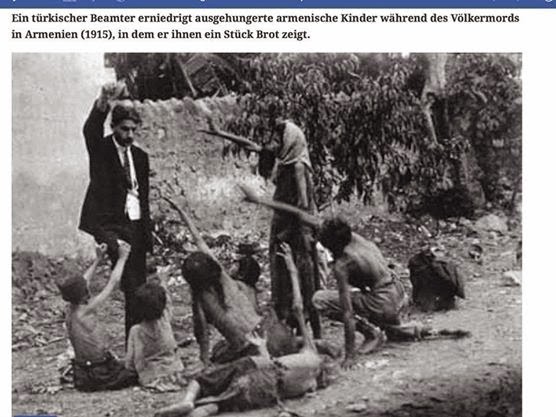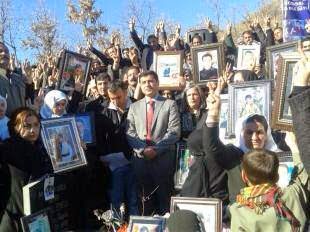By Julian Tumasewitsch:
Genocide against not ‘only’ Armenians, but also Syriacs, Pontic Greeks and Kurdish Yezidin
The first definition of genocide was by Raphael Lemkin, inspired by the extermination of the Armenians, Syriacs (also called Assyrians), Pontic Greeks and Kurds of Yezidin belief in the Ottoman Empire from 1912 to 1922.
Modifications to the definition were made following the experience of the Holocaust during the 3rd Reich. As one of many pieces of evidence showing how similar were these two crimes against humanity, there are the mass graves of about 40.000 Armenian and Syriac genocide victims surrounding the chapel of Margadeh in the Syrian desert (Deir ez-Zor).
Thanks to more than 400 internationally well-reputed historians, it is now broadly understood that the Ottoman Empire’s policy of monoethnisation fulfilled all the criteria of genocide. Outside of Turkey there are only about five historians denying this proven fact by spreading some really strange conspiracy theories. The European Union (Parliamentary Resolutions adopted in 1987, 1998, 2000, 2001, 2002, 2005) and 20 countries have confirmed their recognition that genocide took place. Even Turkey’s recently-founded most democratic parties, the BDP and HDP, recognize this and are pursuing a policy of seriously-meant reconciliation.

Photo taken by the German eyewhitness of genocide, Armin T. Wegner.
It shows an Ottoman state servant humiliating Armenian children, close to starvation, by presenting them a loaf of bread.
The uselessness of Turkey’s proposal for an ‘international group of historians’
The Turkish government’s proposal for an “international group of historians” to examine the contents of its state archives is completely useless, because historians have already proved that all the criteria of genocide are fulfilled. Furthermore, such a group would be dependent on transcription from Arabic into Latin letters by Turkish civil servants. The Ottoman state archives were written in the Arabic alphabet. It is a worldwide standard that historians have to learn two of the following three languages, Latin, Ancient Greek and Sanskrit at university.
In addition, an analysis of numerous eye witness statements as well as of German, American, French, Italian, Scandinavian and Russian state archives already lead to the conclusion that the Ottoman Empire clearly did commit genocide.
This is already the scientific consensus. Only some governments and parliaments hesitate to accept this, because of NATO’s inter-allied policies.
Two years ago, Taner Akcam even found evidence in the obviously not-that-well censored Turkish archives. This indicated clearly that the aim of the Ottoman policy of monoethnisation was to create a 90% Turkish population in each county. The remaining 10% were meant to be absorbed. While Kurds of Sunni and Alevi belief were considered to be absorbable before 1922, the Christians and Yezidin weren’t. So, the result was that the Young Turks established a committee to process a plan for the extermination of these minorities. One of this plan’s main architects was Baheddin Cakir, the Turkish equivalent to Adolf Eichmann in Nazi Germany.
Suppression of the Kurds began shortly after the genocide
Futhermore, after all Christian minorities had been exterminated or expelled and expropriated, there were the numerous massacres and suppression by the Turkish state against its Kurdish population from the 1930s up to 2011 (for example, Zilan, Dersim, Kahranmaras, Sivas and Roboski). These were especially directed against those of Alevi confession, such as in the province of Dersim in 1938 and 1939, when more than 30.000 Kurd civilians were massacred, and they show a causal relationship with not ‘only’ (as if it wouldn’t be bad enough) the Armenian (Aghet’) but also the Syriac (‘Sayfo’) Pontic Greek and Kurdish Yezidin genocides.
Some historians say that one reason for the massacres in Dersim, carried out by the Turkish army, is the fact that the Kurds there helped Armenian and Syriac refugees, just as many Dutch people helped the Jews in the 2nd World War. Another historical example of the same causal relationship is the mass killings of Jews in Turkey in 1934 during the Thrace pogroms.
Kurdish language and cultural customs were forbidden in general for nearly eight decades. Before the so called ‘Turkish War of Independence’ Mustafa Kemal promised autonomy to the Kurds in order to get them allied to him. However, he soon broke his promise and continued from where the Young Turks had been stopped at the end of the 1st World War.
Although some reforms have been introduced to enhance the rights of the Kurds in Turkey, their language and culture is still not equal but restricted, for example, by article 222 of the Turkish penal code (Türk Ceza Kanunu), and Turkey is far away from fulfilling minority standards according to the International Covenant on Civil and Political Rights (ICCPR).
Turkish attempts to justify an ethnocentric policy and the resulting crimes against humanity are always the same, no matter if it is about the genocide against the Armenians, Syriacs, Pontic Greeks and Kurdish Yezidin or the massacres and suppression of the Kurds. They consist of nothing but historical falsification, inaccurate stereotypes of strange conspiracies and racist criminalisation and defamation labelling four entire ethnic groups as aggressors, terrorists or even traitors to the nation (“vatan hayni”). Even in official Turkish educational books, Syriacs (also Assyrians) are still called traitors to the nation.
So, if you want to understand the ‘Kurdish question’, you need to consider the genocide that the Ottoman Empire did to its Christian minorities, providing plenty of evidence of Turkey’s ongoing policy of monoethnisation and globally-unparalleled nationalism.
Recommended literature (only a small choice) on which this article is based
Doumanis, Nicholas: Before the Nation: Muslim-Christian Coexistence and its Destruction in Late-Ottoman Anatolia.
Alexander Laban Hinton, Thomas La Pointe, Douglas Irvin-Erickson (Eds.): Hidden Genocides: Power, Knowledge, Memory.
Kostos, Sofia Kontogeorge (Ed.): Before the Silence: Archival News Reports of the Christian Holocaust That Begs to be Remembered.
Üngör, Uğur Ümit; Polatel, Mehmet: Confiscation and Destruction: the Young Turk Seizure of Armenian Property.
The Asia Minor Catastrophe and the Ottoman Greek Genocide: Essays on Asia Minor, Pontos und Eastern Thrace, 1912-1922.
The Slow Disappearance of the Syriacs from Turkey: And of the Grounds of the Mor Gabriel Monastery.
Taner Akçam: Young Turks’ Crime Against Humanity: The Armenian Genocide and Ethnic Cleansing in the Ottoman Empire.
Raymond Kevorkian: The Armenian Genocide: A Complete History.
Dündar, Fuat: Crime of Numbers: The Role of Statistics in the Armenian Question (1878-1918).
Sarafian, Ara: Talaat Pashas Report on the Armenian Genocide, 1917.
Besikci, Ismail; International colony Kurdistan.
Besikci, Ismail; Tunceli Kanunu ve Dersîm Jenosidi (only in Turkish language; “The Tunceli law and the Dersim genocide”)
Besikci, Ismail; Wir wollen frei und Kurden sein – Brief an die UNESCO (in German language “We want to be free and Kurds – letter to the UNESCO”)
Hans-Lukas KIESER; Dersim Massacre, 1937-1938.
Julian Tumasewitsch was born in 1985 in Weilburg, Germany. Although quite a rural region, it is a real melting pot, where all kind of nationalities come together including Turkish, Kurdish, Armenian, Greek and Alevi immigrants. Julian studied linguistics and political science at the University of Gießen. The city of Gießen is home to Germany’s biggest Syriac community and so he started to examine the history of ethnic and religious minorities of Asia Minor and the Middle East in a scientific way. This is Julian’s blog
.jpg)




Turkish Official photo is fake, as the so called genocide. See it here: http://groong.usc.edu/orig/ak-20100222.html Please don’t believe everything you heard. Manipulated photos don’t make a genocide. Besides Armenians were the genociders of Muslims. Middle east is oppressed by imperialism, and Armenians are the servants of it. Read Armenia’s firts prime minister Hovhannes Katchaznouni, who says it was a plot created by empires.